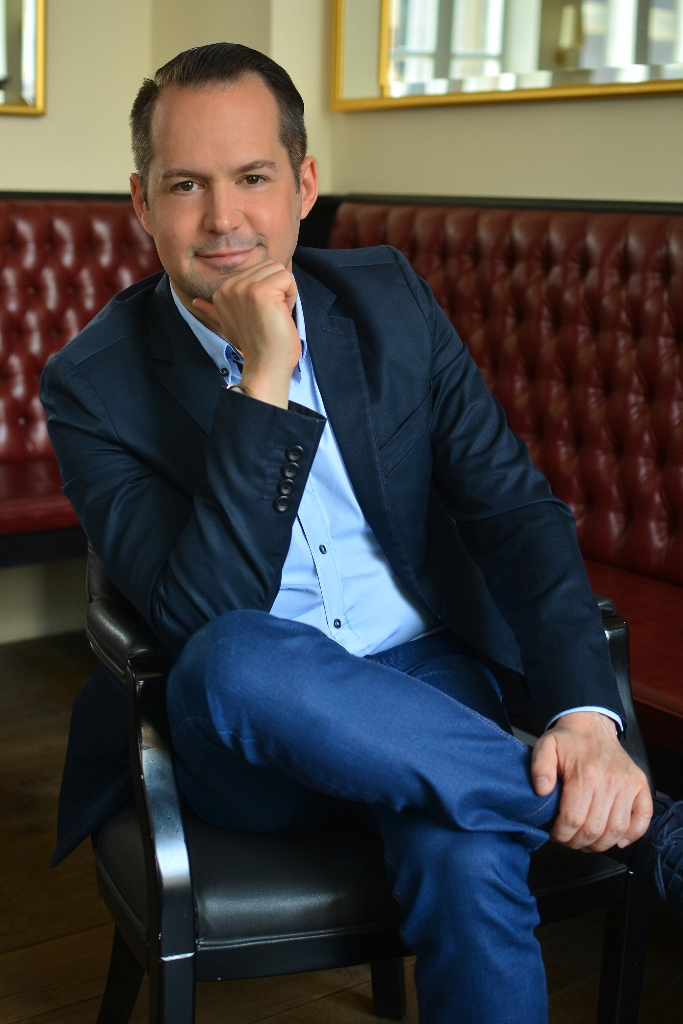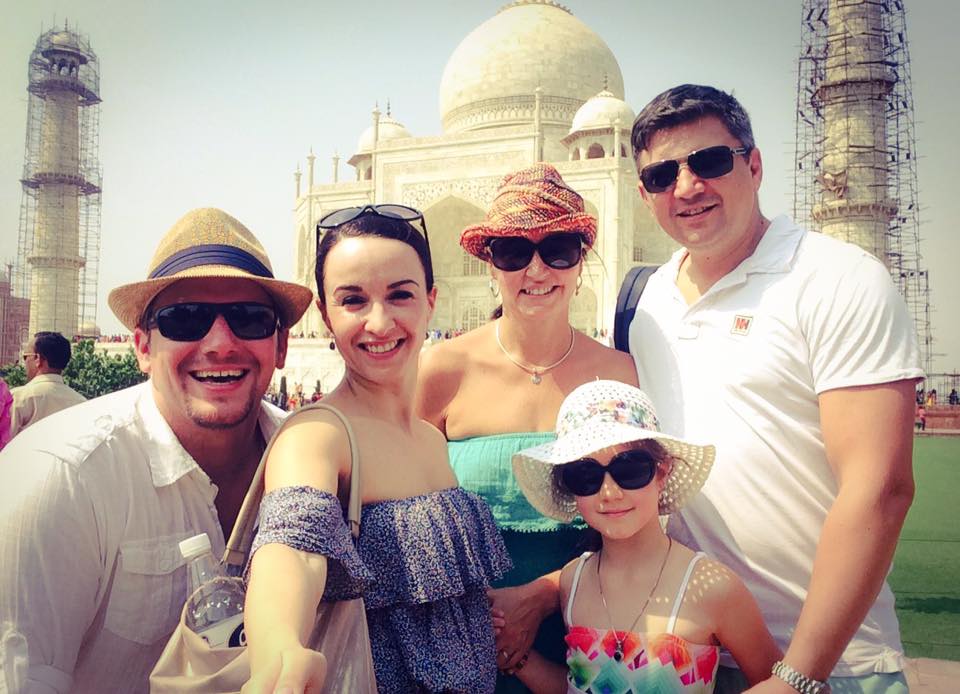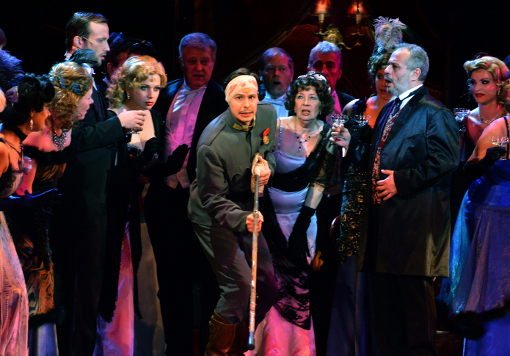Kevin Clarke
Operetta Research Center
27 October, 2016
András Szentpéteri is the head of Pentaton Concert and Artist Management, the company in charge of organising the international tours of the Budapest Operetta Theater. He has brought Hungarian Operetta to such unlikely places as Oman, Qatar and India. And he was recently invited to the Ohio Light Opera Festival in Wooster to talk about his vision of the genre. We spoke with András about some of the more controversial things he outlined in Ohio, and about some of the future plans for Budapest: which include a new theater, a revival of Riviera Girl, and a production of She Loves Me.

András Szentpéteri, head of Pentaton Concert and Artist Management. (Photo: Pentaton)
You presented a talk at the Ohio Light Opera recently, outlining a new program to promote “Hungarian Operetta.” Can you tell us a bit more about this program and what it includes?
The exact title was “Operetta – Hungaricum”. The main aim of my presentation was to show how and why the Hungarian Operetta genre became a part of the intellectual cultural heritage of Hungary (which is what “Hungaricum” really means). I spoke extensively about the main aim of creating Hungaricums through various examples: “palinka,” “Tokaji wines,” “winter salami,” “Kalocsa” and “Matyó embroidery” etc. It is important to know that in this illustrious and diverse company, Hungarian Operetta is the only theatrical genre. I gave an overview of the history of operetta in Hungary: after several German language renditions, the first operetta that was presented in Hungarian was Offenbach’s Marriage by Lantern Light on the 22nd of September, 1860. However, another 25 years passed until the first original Hungarian Operetta was born: József Konti’s and Antal Deréky’s Eleven Ördög (“The Vivid Devil”). While this piece had not received a widespread international acclaim, Jenő Huszka’s Prince Bob was an immediate hit!
And after that came the great operetta trio: Kálmán, Lehár and Ábrahám; they flooded the audience with world-famous melodies – and also emphasized the buffo and soubrette roles in their pieces with the help of what German people call “Paprika im Blut” (paprika in the blood), which still to this day defines Hungarian Operetta. I presented numerous videos, excerpts from Budapest Operetta and Musical Theatre’s shows, from which the attendees of the symposium could get a small taste of the virtuoso choreographies that are so typical of us and the musical additions and re-orchestrations that go along with these.
Recently, Barrie Kosky stated in an interview with the Österreichische Musik-Zeitschrift (ÖMZ) that the performers of the Budapest Operetta Theater are “the true and only heirs of the all-round bravura performance style that was standard before 1933/38 and that has been lost since.” How would you describe what is different in terms of acting/singing with the current BOT ensemble – as compared to Ohio Light Opera, Komische Oper and maybe Volksoper Wien?
I think it is impossible to compare the four theatres, as there is only one thing that they have in common: they perform operettas in a very high level. The performance style, however, is very different. Berlin is boldly modern (in a good sense), Vienna insists on performing according to what they consider to be “in the original score,” most of the time at least, and Ohio focuses on playing lost musical gems, early American musicals, and they performs in a old-fashioned operetta style that allows for absolutely nothing strange or provocative.
Budapest, on the other hand, seeks other ways to renew the genre: we are introducing minor and major changes to the libretto, including new songs to certain operettas – and while singing is very important to us, we also put heavy emphasis on choreography and tempo.
For example, our buffo-soubrette pairs are very good dancing actors, rather than singers. The readers of the Operetta Research Center must know, as there was a long report about it, that Budapest audiences recently had the chance to witness the rebirth of Emmerich Kálmán’s The Duchess of Chicago. It received widespread acclaim from the public, and both the copyright owner (Weinberger Ltd.) and Yvonne Kálmán, daughter of the composer, highly recommend the show to everyone.
Kosky also says that the style of production in Budapest is “a matter of taste.” Do Budapest audiences have a different taste than Berlin or Broadway or Wooster audiences?
Yes, everything is a matter of taste. But regardless of artistic directors forcing their stylistic vision on audiences: if the public does not like the final result and will not buy the tickets, then the production will fail. The audiences of Budapest really enjoy shows that are classic and modern at the same time. Certainly, the standards of our productions had increased heavily since 2002, under the direction of KERO, and later, György Lőrinczy. A few days ago I saw a matinee performance of Die Csárdásfürstin. It was a full sold out house despite the fact that this show has been on our repertoire for decades.
However, I am sure that for Wooster audiences, a Berlin or Budapest show would be “too much.”
There were people who came up to me after my lecture on Ohio, and asked if we at Budapest only perform in this virtuoso acrobatic Cirque de Soleil style. It was because they really liked the choreographies, but feared that the productions lose their original artistic values.
One of these people was a musicologist; so I reassured him that we have original, more classic performances, as well.
And after that we had a great debate (with others joining in) about the ways of renewal for the genre. And I can say that everyone agreed that we need to reform these operetta pieces, because they cannot be performed as they were on their opening nights. One fine example for this is a very recent achievement: the new, modern choreographies of the Wooster productions – the new choreographer, Spencer Reese, choreographed 7 productions, which is a lot, considering that we are talking about a 2 months long summer festival.
Your company – Pentaton Concert and Artist Management – has actively brought Hungarian Operetta to India, Oman, Qatar etc. in recent months. How were the reactions to this particular sub-division of operetta in these far-away places? Why do you think it’s important to export Hungarian Operetta to these places?
Well, it is really nice to be the first. To tell the truth, it was my idea to bring Hungary’s most exportable artistic “product”, Die Csárdásfürstin to Arab countries. In the case of the Royal Opera House of Muscat, we got really lucky, because the members of the local staff were simply fantastic. After that, half of the company moved to Doha to present a gala show for the 100 years anniversary of this operetta show. We received a standing ovation in both venues, which is really not typical of these audiences.

The soloists of the Budapest Operetta Theater in front of the Taj Mahal. (Photo: Pentaton)
It’s true that only 10 percent of the audience was made up of locals, the rest were expats from Oman or Qatar, but they really enjoyed the performance, as well. And the expats: even more! I believe it is my mission to bring Hungarian Operetta, and the operetta genre to such “unconquered” lands.
In Germany, many people are highly skeptical of Viktor Orban’s “nationalistic” approach to politics and culture. Some don’t see this emphasis on “Hungarian” composers, writers and shows not as a sympathetic and positive preservation of culture, but as an unpleasant ideological “rape.” How do you – and how does BOT – deal with these concerns?
I don’t do politics. Our job is to bring Hungarian culture to people all around the world, regardless of governments and political parties. And I have to say that the current cultural leadership is very supportive about this cause: in cooperation with one of the central offices of the Hungarian Ministry of Foreign Affairs and Trade – the former Balassi Institute, which managed the operation of all foreign Hungarian Cultural Institutes – and with the help of the First World War Centenary Memorial Committee, we were able to organize a world tour for the concert version of Die Csárdásfürstin. With their support, we will be able to bring this show to four major Chinese cities soon.

Scene from the Budapest production of “Csardasfürstin.” (Photo: Budapesti Operettszínhás)
Does the new outlook and focus on “Hungarian” operetta mean that BOT and Pentaton will only perform “national heritage” shows in the future, or will musical comedy and operetta still be presented in context with other repertoire elements?
It was never the case. Budapest Operetta and Musical Theatre has always been presenting pieces from Offenbach, Fall and Strauss, as well. However, it is true that our audience prefers Kálmán, Lehár, Huszka and Ábrahám, but this is an entirely different matter.
And of course we are regularly putting on literature- or history-based musicals, too.
Next summer, we will debut Alan Menken’s and Stephen Schwartz’s The Hunchback of Notre Dame, but we also plan to stage the Broadway revival version of the musical comedy She Loves Me, which is an American piece but still has some Hungarian connections, since the play it is based on (Parfumerie) was written by Hungarian playwright Miklós László.

The stage of the Kalman Theatrum in Budapest. (Photo: Budapest Operetta Theater)
The BOT will soon re-open the small “nightclub” theater next door. What will be performed there? And will these small productions also go on tour?
This is not a nightclub, but a real theatre, which is going to be named after Emmerich Kálmán. It will open to the audience next spring, and will be able to house around 200-250 people. Of course, we will open with a Kálmán show: we are planning to present a compilation of his less well known works in the form of a full length play. And hopefully Riviera Girl – the original 1917 Broadway version of Csárdásfürstin – will also return to the stage here, after long decades of absence. Even the publisher of Kálmán’s works, Weinberger Ltd., knew nothing of the libretto of the piece.

Sheet music cover for “Life’s a Tale” from Kálmán’s “The Rviera Girl.”
In Ohio, during a roundtable discussion, all attendees were asked a question by artistic director Steve Daigle, who wanted to know which long lost piece would we like to see return to the stage. I mentioned Riviera Girl, which has a libretto written by P. G. Wodehouse. I also added that the piece was gone, unfortunately. Two days later during dinner, one of my colleagues and ORCA collaborator, Richard C. Norton, who is one of the most important collectors of musical theatrical works in America, turned to me and said: “András, I found your lost Kálmán piece, one of my friends has it.”
Two days later I received the libretto in email. All that is left is the compilation of the songs: we have the resources, but it is a big enough task. Even Jerome Kern had written two or three songs for this version.
In Ohio, you mentioned the necessity of re-writing and re-orchestrating operettas to make them “more accessible to new and young audiences accustomed to different popular music styles.” Can you outline explain what it means for the shows?
Well, this is one grand topic. I suggested to Michael Miller, chairman of the Ohio Light Opera’s board, to organize a symposium about this in two years time, when they will celebrate their 40th anniversary. One thing is for sure: there is a great need and a wide appeal for renewal from the audience’s side.
You celebrated “100 Years of Csardasfürstin” last year with a gala and conference in Budapest. What will be the next milestone in your programming?
Budapest Operetta and Musical Theatre presented a Hungarian musical Lady Budapest by Tibor Kocsák a few days ago that takes place in 1956, to honour the 60th anniversary of the revolution.
But next spring, Lehár’s Merry Widow will also return to the stage; we will open the Emmerich Kálmán Theatre, and continue our tours. In Ravenna during the fall, we had a week on which we presented Hungarian operetta pieces as well. We also continue our concert tour Die Csárdásfürstin 100 with shows in London, Rome, Vojvodina, Ukraine, Transylvania and China.

András Szentpéteri (far right) with the Budapest Operetta Theater team, on the way to another foreign place. (Photo: Pentaton)
